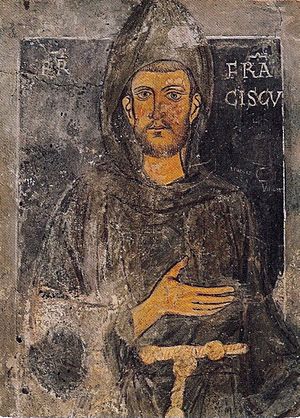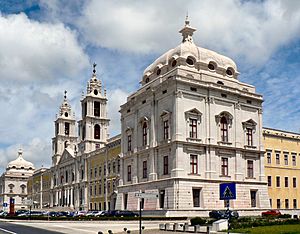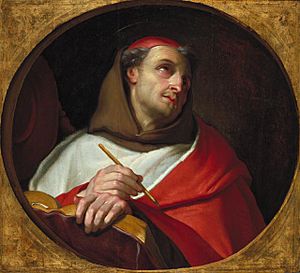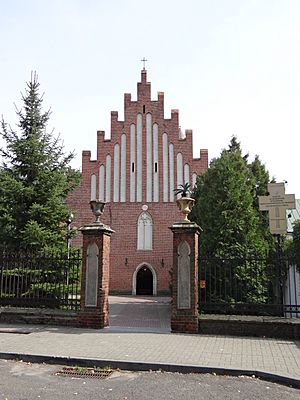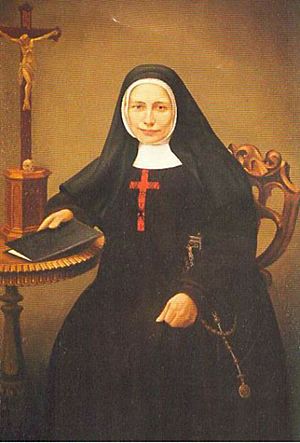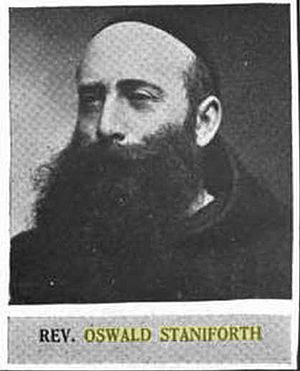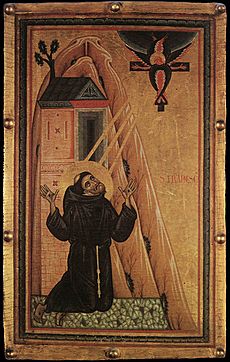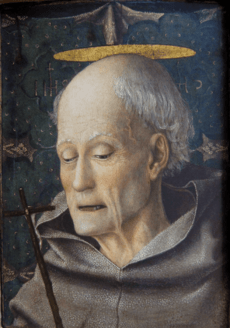Franciscans facts for kids
|
Latin: Ordo Fratrum Minorum
|
|
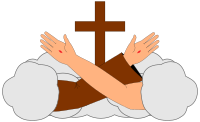
A cross, Christ's arm and Saint Francis's arm, a universal symbol of the Franciscans
|
|
| Abbreviation | OFM |
|---|---|
| Formation | 24 February 1209 |
| Founder | Francis of Assisi |
| Type | Mendicant Order of Pontifical Right for men |
| Headquarters | Via S. Maria Mediatrice 25, 00165 Rome, Italy |
|
Membership
|
12,476 members (8,512 priests) as of 2020 |
|
Motto
|
Pax et bonum (Latin) Peace and [all] good |
|
Minister General
|
Fr. Massimo Fusarelli, OFM |
|
Parent organization
|
Catholic Church |
| Subsidiaries | Secular Franciscan Order (1221) Third Order of Saint Francis (1447) |
| Secessions | OFM (1897) OFM Conventual (1517) OFM Capuchin (1520) |
|
Formerly called
|
Order of Observant Friars Minor |
The Franciscans are a group of religious orders within the Catholic Church. They are known as "mendicant" orders. This means their members traditionally live by begging for food and do not own property. The Franciscans were founded in 1209 by an Italian saint named Francis of Assisi.
These orders include three main groups for men. The largest one today is the Order of Friars Minor. There are also orders for nuns, like the Order of Saint Clare. Plus, there's the Third Order of Saint Francis, which is open to both men and women. All Franciscans follow the teachings and spiritual ideas of Saint Francis. They also look to other important figures like Saint Clare of Assisi, Saint Anthony of Padua, and Saint Elizabeth of Hungary.
Francis started preaching around 1207. In 1209, he went to Rome to get approval from Pope Innocent III for his new religious group. The first rule approved by the Pope said that members could not own property. They had to beg for food while they preached. This strict way of life was meant to be like the life of Jesus Christ. Franciscans traveled and preached in towns, often staying in church buildings. Saint Clare of Assisi, guided by Saint Francis, started the Poor Clares (Order of Saint Clare) for women.
The very strict poverty rule was made a bit easier in 1223. But how strictly members should follow the rule caused many disagreements. This led to different groups forming within the Franciscans. The Order of Friars Minor, also called the "Observant" branch, is one of the three main Franciscan orders for men in the Catholic Church. The others are the "Conventuals" (started 1517) and "Capuchins" (started 1520). The Order of Friars Minor today was formed in 1897 by Pope Leo XIII, bringing together several smaller groups. The Capuchins and Conventuals are still separate groups. They follow the Rule of Saint Francis but with different focuses. Conventual Franciscans are sometimes called minorites or greyfriars because of their gray habit.
Contents
- Understanding the Franciscans
- History of the Franciscans
- Franciscans Today
- What Makes Franciscans Unique?
- Images for kids
- See also
Understanding the Franciscans
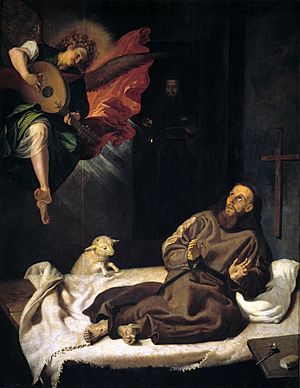
Name and Meaning
The original name of the order is Ordo Fratrum Minorum. This means 'Order of Lesser Brothers'. Saint Francis of Assisi chose this name because he rejected luxury and wealth. Francis came from a rich family of cloth merchants. But he gave up his wealth to live a life of faith. He wanted to live like the poor and ordinary people (called minori). He left behind the life of the wealthy and noble classes (called Majori).
Francis wore a simple tunic, like the clothes of peasants. This became the religious habit for his order. Those who joined him became the first Order of Friars Minor. Francis also called his followers "Fraticelli," which means "Little Brothers." Franciscan brothers are often called friars or Minorites.
Different Branches of Franciscans
Today, the Franciscans are organized into three main groups or "orders." Each group is a religious order with its own leader. They all follow the Rule of Saint Francis.
First Order: Men's Orders
The First Order is for men. These are the main groups of Franciscan friars:
- The Order of Friars Minor (OFM): Also known as the Observants, they are often simply called Franciscan friars.
- The Order of Friars Minor Capuchin (OFM Cap.): These are simply called Capuchins.
- The Order of Friars Minor Conventual (OFM Conv.): These are also known as Minorites.
Second Order: Nuns
The Second Order is mainly for women. They are most commonly called Poor Clares. Their official name is the Order of St. Clare (OSC). Before 1263, they had other names like "The Poor Ladies." This order consists of contemplative sisters. This means they live a life focused on prayer, often within a monastery.
Third Order: Lay People and Religious Communities
The Franciscan third order has many men and women members. They are divided into two main parts:
- The Secular Franciscan Order (OFS): These members live their daily lives outside of religious communities. They try to follow the Franciscan ideals in their regular jobs and families.
- Members of the Third Order Regular (TOR): These members live together in religious communities. They take traditional religious vows like poverty, chastity, and obedience. This group grew out of the Secular Franciscan Order.
How Many Franciscans Are There?
In 2013, here were the numbers for the main male Franciscan orders:
- Order of Friars Minor (OFM): About 12,476 members, including 8,512 priests.
- Franciscan Order of Friars Minor Conventual (OFM Conv.): About 3,981 members, including 2,777 priests.
- Franciscan Order of Friars Minor Capuchin (OFM Cap.): About 10,355 members, including 6,796 priests.
- Third Order Regular of Saint Francis (TOR): About 813 members, including 581 priests.
The Franciscan symbol is a Tau cross. It shows two crossed arms: Christ's right hand with a nail wound and Francis' left hand with a stigmata wound.
History of the Franciscans
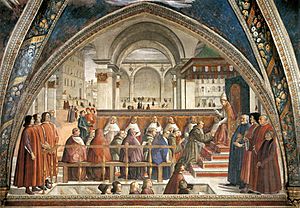
How It Began
In 1209, Francis heard a sermon that deeply moved him. He decided to live a life of complete poverty, like the apostles. He wore simple clothes, went barefoot, and carried no money. He began to preach about repentance.
Soon, others joined him. One of the first was Bernard of Quintavalle, a wealthy townsman who gave away all his money. Within a year, about eleven companions had joined Francis. They lived in a deserted leper colony near Assisi. But they spent most of their time traveling and preaching in the mountains of Umbria. They were always cheerful and sang songs. Their serious messages made a deep impression on people. Their life was very simple and strict. The first rule Francis gave them (around 1209) was mostly a collection of Bible verses about poverty.
Despite some similarities to other groups, Francis's brotherhood gained the approval of Pope Innocent III. The Pope was impressed by their strong loyalty to the Catholic Church. Innocent III likely saw them as a way to spread orthodox teachings and counter false ideas. Francis was ordained as a deacon. This allowed him to read from the Gospel and preach in churches during Mass.
Francis's Later Years
As the order grew, Francis faced challenges. It became a more formal order with strict rules from Rome. In 1219, Francis asked Pope Honorius III for help. Cardinal Ugolino was assigned to protect the order. Francis stepped back from the daily running of the order. But he still helped shape its rules. He wrote a new Rule in 1221, which was approved in 1223.
After 1221, Brother Elias of Cortona managed the order day-to-day. Elias was a skilled friar. He was later elected as the leader after Francis's death in 1232. Elias planned and built the Basilica of San Francesco d'Assisi. This church holds the body of Francis of Assisi. It also includes the Sacro Convento friary, which is still the spiritual center of the order today.
The Franciscans spread quickly. In 1221, Caesarius of Speyer started a group in Germany. In 1224, Agnellus of Pisa led friars to England. There, they became known as the "greyfriars." They started in Canterbury, then went to London and Oxford. From these places, Franciscans expanded to major towns across England.
Disagreements During Francis's Life
Discussions about how strictly to follow the Gospel life of poverty began while Francis was still alive. This issue continued for centuries. Some friars wanted stricter rules, while others wanted more flexibility. Elias of Cortona, for example, wanted the order to have more worldly importance. This went against Francis's original ideas.
Francis and others who wanted to stick to his original views were called Observantists. They were just as numerous and active as Elias's followers.
Franciscans in the Holy Land
After much work in Italy, Francis went to Egypt in 1219. He joined the Fifth Crusade to share the Gospel with the Saracens. He met with Sultan Malik al-Kamil. This meeting started a spirit of dialogue between Christianity and Islam.
Franciscans arrived in the Holy Land in 1217. By 1229, they had a small house near the fifth station of the Via Dolorosa. In 1272, Sultan Baibars allowed them to settle in the Cenacle on Mount Zion. Later, in 1309, they also settled in the Holy Sepulchre and in Bethlehem. In 1335, the king of Naples, Robert of Anjou, and his wife Sancha of Majorca bought the Cenacle. They gave it to the Franciscans. In 1342, Pope Clement VI officially declared the Franciscans as the guardians of the Holy Places for the Catholic Church.
The Franciscan Custody of the Holy Land continues this role today.
After Francis's Death
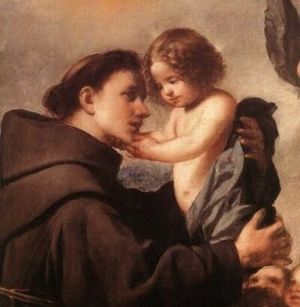
Elias of Cortona, who was a lay friar, encouraged other laymen to join the order. This caused problems with many ordained friars. Pope Gregory IX wanted to build a grand church for Francis's body. Elias was given this task. He started collecting money for the building. This upset the strict Franciscans who felt it went against Francis's ideas about poverty.
Brother Leo, a close friend of Francis, strongly opposed Elias. He even broke a marble box Elias set up for donations. Elias had Leo punished for this. This made many friars oppose Elias. In 1227, Elias was removed as leader. Giovanni Parenti was elected instead.
In 1232, Elias became the leader again. Under him, the order grew in towns. Many new houses were built. Education became important, and Franciscan teachers were sent to universities. Money was collected for the order's work, especially for the Basilica in Assisi. In 1230, the friars asked Pope Gregory IX to clarify the Rule of 1223. The Pope said that Francis's Testament was not legally binding. He allowed the order to accept funds for necessary things. Elias was very strict with those who opposed him.
The disagreement between the strict and less strict groups lasted many years. Eventually, it became clear they could not agree. The order officially split into different branches.
Changes from 1239 to 1274
Elias governed the order very centrally. But friars in England and Germany wanted more local control. In 1239, Elias was removed. Albert of Pisa became the new leader. He was a moderate Observantist. This change brought more democracy to the order. The next leaders, Haymo of Faversham (1240–44) and Crescentius of Jesi (1244–47), made the order more organized. Pope Innocent IV supported them. In 1245, the Pope even allowed funds to be used for things that were "useful," not just "necessary."
The strict Observantist party strongly opposed this. They worked against the less strict leader. In 1247, John of Parma (1247–57) became the new leader. He was a strict Observantist. The order refused to follow the laxer rules from Pope Innocent IV.
Elias, who had been excommunicated, died in 1253. Under John of Parma, the order's influence grew. This was especially true because of the Pope's support for the friars' academic work. The Pope supported theological studies in Franciscan houses. He also helped the friars during a conflict with university teachers and bishops in France. Thanks to Pope Alexander IV, Thomas Aquinas (Dominican) and Bonaventure (Franciscan) finally received their doctor of theology degrees in 1257.
A Franciscan named Gerard of Borgo San Donnino wrote a controversial text. John of Parma was seen as supporting these ideas. To protect the order, John stepped down. He suggested Bonaventure as his replacement. Bonaventure wanted to unite the order. He wrote a new life story of Francis and collected the order's laws. These laws were approved in 1260. In 1263, Bonaventure's biography of Francis was approved as the only official one. All older biographies were ordered to be destroyed. Bonaventure led the order from 1257 to 1274 in a balanced way.
14th Century Challenges
Leaders and Divisions
After Bonaventure, leaders like Jerome of Ascoli (1274–79), who later became Pope Nicholas IV, and Bonagratia of Bologna (1279–85) tried to find a middle ground. Strict measures were taken against some extreme "Spirituals." These were friars who believed the order should be even poorer. Pope Nicholas III (1279) issued a bull (a papal order) that said complete poverty was good. But it also tried to explain how the friars could use things without owning them.
The "Spiritual" party, led by Pierre Jean Olivi, felt this rule still corrupted the order's main ideas. They were not happy with the next leaders. Pope Celestine V, a friend of the order, tried to unite the strict Observantists with his own hermit order. But this did not work well. Pope Boniface VIII later canceled Celestine's actions. He removed the general leader Raymond de Gaufredi and appointed a less strict one. The strict Observantist leader, Olivi, died in 1298. He had argued against the most extreme "Spiritual" views.
Persecution and Suppression
Under Pope Clement V (1305–14), the strict party gained some influence. In 1309, Clement set up a group to try and reconcile the different Franciscan parties. Ubertino of Casale, a leader of the stricter party, influenced the Council of Vienne. The papal order Exivi de paradiso (1313) mostly favored the stricter views.
But Clement's successor, Pope John XXII (1316–34), favored the less strict group, called the Conventuals. He changed some rules and demanded that the Spirituals formally submit. Some Spirituals, encouraged by their leader Michael of Cesena, questioned the Pope's right to do this. Sixty-four of them were called to Avignon. The most stubborn ones were handed over to the Inquisition. Four of them were burned in 1318. Before this, all the separate houses of the Observantists had been closed down.
Separate Groups and Reforms
From these disagreements in the 14th century, many separate groups formed. Some were even considered heretical. But others developed within the order, following either hermit or community living styles.
The Clareni
The Clareni were a group of hermits started by Angelo da Clareno in 1337. Like other smaller groups, they were forced to join the main Observantists in 1568 by Pope Pius V.
Reform of Johannes de Vallibus
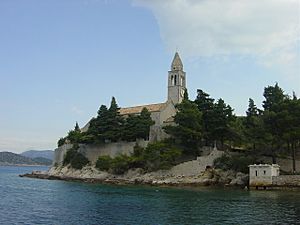
This reform started in 1334 near Foligno. The group was closed in 1354 but restarted in 1368 by Paolo de' Trinci. It quickly spread from Italy to France, Spain, and Hungary. Most Observantist houses joined this group. It became known as the "brothers of the regular Observance." They gained favor from the popes by opposing the heretical Fraticelli. The Council of Constance (1415) officially recognized them. They were allowed to have their own leader and make their own rules.
Through the work of men like Bernardino of Siena and Giovanni da Capistrano, they became very important in the 15th century. By the end of the Middle Ages, the Observantists had 1,400 houses. This was almost half of the entire order. Their influence even led to reforms among the Conventuals.
Unification Efforts
Many popes and councils tried to unite the two main branches of the order. But nothing worked. In 1430, John of Capistrano created rules for reunion. A general meeting in Assisi accepted them. But most Conventual houses refused, so it failed. Pope Eugene IV tried again in 1446, but it was also unsuccessful.
Finally, Pope Leo X made the division official in 1517. This happened after a general meeting in Rome. The less strict rules of the Conventuals, which allowed them to own property, were accepted. The Observants, however, were held strictly to their own very simple way of life.
All groups that followed the Franciscan Rule strictly were united with the Observants. This united group was given the right to elect the Minister General of the Order. They were also given the official seal of the order. This group, because it followed the founder's rule more closely, was seen as superior to the Conventuals. The Observant general was called "Minister-General of the Whole Order of St. Francis."
New World Missions
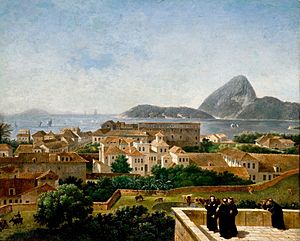
Franciscans started their work in New Spain (modern-day Mexico) in 1523. Three Flemish friars arrived in the central highlands. Their mission work was small at first. But Fray Pedro de Gante began the process of spreading Christianity. He learned the Nahuatl language from children of Indian leaders.
Later, in May 1524, the Twelve Apostles of Mexico arrived, led by Martín de Valencia. They built the Convento Grande de San Francisco. This became the main Franciscan center in New Spain for 300 years.
Franciscans Today
First Order: Men's Communities
Order of Friars Minor
The Order of Friars Minor (OFM) has about 1,500 houses in 100 regions. They have about 16,000 members. In 1897, Pope Leo XIII combined several smaller groups into this one order. These groups included the Observants, Discalced, Recollects, and Riformati. Even with some disagreements from this forced union, the order grew. It reached its largest size of 26,000 members in the 1960s. The order is led by a Minister General. Since July 2021, this leader is Father Massimo Fusarelli.
Order of Friars Minor Conventual
The Order of Friars Minor Conventual (OFM Conv.) has 290 houses around the world. They have almost 5,000 friars. They have been growing this century in many parts of the world. They are found in Italy, the United States, Canada, Australia, Latin America, and Africa. They have the most members in Poland, inspired by Maximilian Kolbe.
Order of Friars Minor Capuchin
The Order of Friars Minor Capuchin (OFM Cap.) is the newest branch of Franciscans. It was founded in 1525 by Matteo Serafini. He was an Observant friar who wanted to follow Franciscan rules even more strictly. With the Pope's support, this new branch grew quickly. First in Italy, then across Europe and the world after 1574. The Capuchins became a separate order in 1619. Their name "Capuchins" comes from the special shape of their long hood (capuce). It was a popular nickname that became part of their official name. Today, the order is in 106 countries. It has about 10,500 brothers living in over 1,700 communities, called fraternities or friaries.
Second Order: Poor Clares=
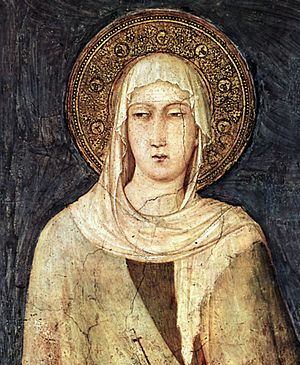
The Poor Clares, officially the Order of Saint Clare, are nuns in the Catholic Church. They belong to a contemplative order, meaning they focus on prayer. The Poor Clares were the second Franciscan order to be started. Clare of Assisi and Francis of Assisi founded them in 1212. This was after the Order of Friars Minor (the first order) and before the Third Order of Saint Francis. In 2011, there were over 20,000 Poor Clare nuns in more than 75 countries. They follow different ways of life and are organized into groups called federations.
The Poor Clares follow the Rule of St. Clare. This rule was approved by Pope Innocent IV in 1253, the day before Clare died. The main branch of the Order (OSC) follows the rules set by Pope Urban. Other branches have been created since then. These include the Colettine Poor Clares (PCC – founded 1410) and the Capuchin Poor Clares (OSC Cap. – founded 1538).
Third Order: Lay and Religious Communities=

The Third Order of Saint Francis is for people who want to live a holy life. They do this in their daily lives without joining a monastic community. Francis saw a need for this. So, he created a way of life for married men and women, single people, and clergy. They could live according to the Gospel.
Secular Franciscan Order
The Secular Franciscan Order (OFS) was founded by Francis in 1212. It was for brothers and sisters who do not live in a religious community. Members of this order continue to live regular lives. But they meet regularly for activities together. In the United States, there are 17,000 members. Members follow a Rule written by St. Francis in 1221. This Rule was changed over the centuries. In 1978, Pope Paul VI approved a new Rule. The Third Order was then renamed the Secular Franciscan Order. It is an international group with its own leader in Rome.
Third Order Regular
Within 100 years of Francis's death, some Third Order members began to live together. They wanted to follow a more strict way of life. Angela of Foligno (+1309) was famous for her deep prayer life and service to the poor while living in a community of women.
For men, the Third Order Regular of St. Francis of Penance (TOR) was formed in 1447. A papal decree united several communities of hermits following the Third Order Rule into one order. Today, it is an international community of friars. They focus on helping others and on ongoing spiritual growth. They are also known as the Franciscan Friars, TOR. They work to "rebuild the Church" in many areas. These include high school and college education, parish ministry, social justice, and hospital chaplaincies.
After religious tertiary communities were formally recognized, they grew steadily across Europe. Women's communities often took on a monastic way of life. As Europe changed, new communities arose. These focused more on social service, especially after the Napoleonic period. Mary Frances Schervier (1819–1876) is an example of this.
Third Order Regular in North America
This movement continued in North America. Various groups formed to meet the needs of large immigrant communities.
The Third Order Regular of the Brothers of the Poor of St. Francis of Assisi, CFP, is an active community. They are based in the United States, with houses in Belgium, the Netherlands, Germany, and Brazil. These Franciscans aim to live a life of prayer, community, and service to the poor. They help neglected youth, the powerless, and the elderly. The Brothers of the Poor live by their vows of poverty, chastity, and obedience. They serve people with AIDS and anyone who asks for help, no matter their background. They work as teachers, social workers, counselors, and in other roles.
The Regular Tertiaries, officially the Third Order Regular of St. Francis of Penance, run the Franciscan University of Steubenville. They follow a rule approved by Pope Leo X. Today, this group is in 17 countries.
Brothers and Sisters of Penance of St. Francis
The Brothers and Sisters of Penance of St. Francis is a private group in the Roman Catholic Church. Its members try to live their lives according to the original Rule of the Third Order of St. Francis. This rule was written for lay people in 1221 by Francis of Assisi. There are several hundred members in the United States and more worldwide. The group started in 1996 in Minnesota.
Other Franciscan Groups
- In 1435, Francis of Paola founded the "Poor Hermits of Saint Francis of Assisi." They were later called the "Order of Minims" in 1506. They include friars, nuns, and lay members.
- The Society of the Atonement, also known as Graymoor Friars and Graymoor Sisters, started in 1898. They joined the Holy See in 1909.
- The Franciscan Friars of the Immaculate started in 1970. They became an official institute in 1998. The Franciscan Sisters of the Immaculate also became official that same year.
Franciscans in Other Christian Traditions
During the 19th century, some religious orders were re-established in the Anglican Church. These included some inspired by Franciscans. The main Anglican Franciscan groups are the Community of St. Francis (women, founded 1905) (CSF), the Poor Clares of Reparation (PCR), the Society of Saint Francis (men, founded 1934)(SSF), and the Community of St. Clare (women, enclosed) (OSC). There is also a Third Order called the Third Order Society of St Francis (TSSF).
There are also small Franciscan communities in European Protestantism and the Old Catholic Church. Some Franciscan orders in Lutheran Churches exist. These include the Order of Lutheran Franciscans and the Evangelical Sisterhood of Mary.
What Makes Franciscans Unique?
Spirituality
Franciscan theology follows the main teachings of the Catholic Church. But it has some special focuses. Franciscan thinkers see creation and the natural world as good and joyful. They don't focus much on the "stain of original sin." Francis showed great love for animals and nature. He saw them as fellow parts of God's creation. He wrote about this in his work Canticle of the Creatures (also known as the Canticle of the Sun).
They also put special importance on the Incarnation of Christ. This is seen as a great act of humility. Francis was deeply moved by God's great love in sacrificing his son for our salvation. They also show great devotion to the Eucharist. The Rule of Saint Francis asks members to live simply. They should not be attached to material things. This is to be like Jesus's life and ministry on Earth. This simple lifestyle helps members feel connected to the poor. It also helps them work for social justice. Franciscan spirituality also strongly emphasizes protecting the Church and staying loyal to it.
Visions and Stigmata
Among Catholic religious orders, Franciscans have reported more cases of stigmata. Stigmata are bodily marks, sores, or sensations of pain in locations corresponding to the crucifixion wounds of Jesus Christ. Francis of Assisi himself was one of the first reported cases of stigmata. Another famous stigmatic was Padre Pio, a Capuchin friar. He also reported visions of Jesus and Mary.
Contributions to Biblical Studies
The Franciscans created the Studium Biblicum Franciscanum. This is an academic society in Jerusalem and Hong Kong for studying the Bible. The Hong Kong branch was founded by Gabriele Allegra. In 1968, after 40 years of work, they produced the first complete translation of the Catholic Bible in Chinese. This translation is often seen as the official Chinese Bible for Catholics.
The early work of another Franciscan, Giovanni di Monte Corvino, inspired Gabriele Allegra. Monte Corvino had tried to translate the Bible in Beijing in the 14th century. Allegra was 21 when he attended a celebration for Monte Corvino. This sparked his 40-year project.
Famous Franciscans
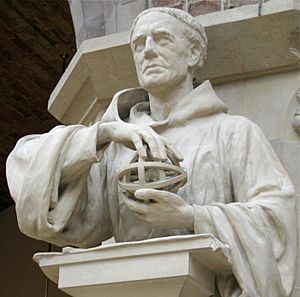
The Franciscan order has had many important members. From its first century, there were great scholars like Alexander of Hales, Bonaventure, and John Duns Scotus. There was also the scientist Roger Bacon. Famous mystic writers and preachers included David of Augsburg and Berthold of Regensburg.
During the Middle Ages, other notable members included Nicholas of Lyra (a Bible commentator), philosopher William of Ockham, and preachers John of Capistrano.
In Christian art, the Franciscan movement had a big impact, especially in Italy. The ideas of Francis influenced painters like Cimabue and Giotto. Even though they weren't friars, they were spiritually connected to Francis. The Italian Gothic style of architecture was often used by members of the order or those influenced by them. The great convent church at Assisi (built 1228–53) is an early example.
Early Italian spiritual poetry was partly inspired by Francis himself. He was followed by poets like Thomas of Celano, Bonaventure, and Jacopone da Todi. Even Dante is sometimes included in this artistic tradition.
Other famous Franciscans include Anthony of Padua, François Rabelais, Pio of Pietrelcina, Maximilian Kolbe, Junipero Serra, and Benedict Groeschel.
During the "spiritual conquest" of New Spain (1523–1572), the first Franciscans arrived. These included the Twelve Apostles of Mexico. Toribio de Benavente Motolinia wrote many important texts about these early years. Other important Franciscans were Alonso de Molina, Andrés de Olmos, and Bernardino de Sahagún. They created texts in the native Nahuatl language to help friars spread Christianity in Mexico.
A modern notable member is Father Casey Cole, O.F.M.. He is an American Franciscan friar, Catholic priest, writer, and blogger. Cole runs his own online blog and YouTube channel called Breaking in the Habit. He has also written books.
Images for kids
-
Honorius III Approving the Rule of St. Francis of Assisi, Bartolome del Castro, c. 1500 (Philadelphia Museum of Art)
See also
 In Spanish: Orden Franciscana para niños
In Spanish: Orden Franciscana para niños
- Association of Franciscan Colleges and Universities
- List of Ministers General of the Order of Friars Minor
- Maria Antonio of Vicenza
- List of Franciscan saints


